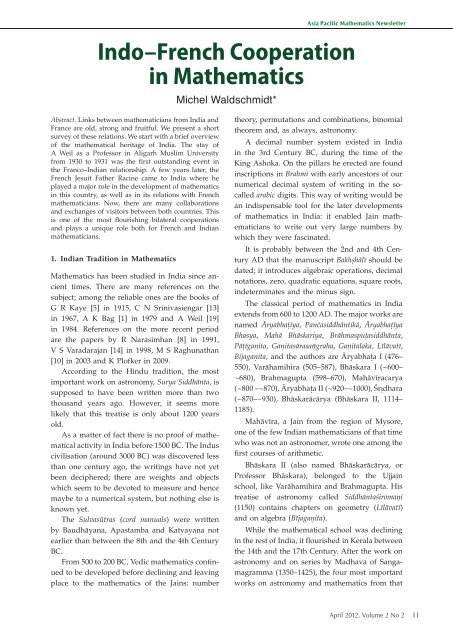Mathematics Newsletter
Mathematics Newsletter
Mathematics Newsletter
You also want an ePaper? Increase the reach of your titles
YUMPU automatically turns print PDFs into web optimized ePapers that Google loves.
Indo–French Cooperation<br />
Asia Pacific <strong>Mathematics</strong> <strong>Newsletter</strong><br />
1<br />
Indo–French Cooperation in <strong>Mathematics</strong><br />
Abstract. Links between mathematicians from India and<br />
France are old, strong and fruitful. We present a short<br />
survey of these relations. We start with a brief overview<br />
of the mathematical heritage of India. The stay of<br />
A Weil as a Professor in Aligarh Muslim University<br />
from 1930 to 1931 was the first outstanding event in<br />
the Franco–Indian relationship. A few years later, the<br />
French Jesuit Father Racine came to India where he<br />
played a major role in the development of mathematics<br />
in this country, as well as in its relations with French<br />
mathematicians. Now, there are many collaborations<br />
and exchanges of visitors between both countries. This<br />
is one of the most flourishing bilateral cooperations<br />
and plays a unique role both for French and Indian<br />
mathematicians.<br />
1. Indian Tradition in <strong>Mathematics</strong><br />
<strong>Mathematics</strong> has been studied in India since ancient<br />
times. There are many references on the<br />
subject; among the reliable ones are the books of<br />
G R Kaye [5] in 1915, C N Srinivasiengar [13]<br />
in 1967, A K Bag [1] in 1979 and A Weil [19]<br />
in 1984. References on the more recent period<br />
are the papers by R Narasimhan [8] in 1991,<br />
V S Varadarajan [14] in 1998, M S Raghunathan<br />
[10] in 2003 and K Plofker in 2009.<br />
According to the Hindu tradition, the most<br />
important work on astronomy, Surya Siddhānta, is<br />
supposed to have been written more than two<br />
thousand years ago. However, it seems more<br />
likely that this treatise is only about 1200 years<br />
old.<br />
As a matter of fact there is no proof of mathematical<br />
activity in India before 1500 BC. The Indus<br />
civilisation (around 3000 BC) was discovered less<br />
than one century ago, the writings have not yet<br />
been deciphered; there are weights and objects<br />
which seem to be devoted to measure and hence<br />
maybe to a numerical system, but nothing else is<br />
known yet.<br />
The Sulvasūtras (cord manuals) were written<br />
by Baudhāyana, Apastamba and Katyayana not<br />
earlier than between the 8th and the 4th Century<br />
BC.<br />
From 500 to 200 BC, Vedic mathematics continued<br />
to be developed before declining and leaving<br />
place to the mathematics of the Jains: number<br />
Michel Waldschmidt∗ in <strong>Mathematics</strong><br />
Michel Waldschmidt*<br />
theory, permutations and combinations, binomial<br />
theorem and, as always, astronomy.<br />
A decimal number system existed in India<br />
in the 3rd Century BC, during the time of the<br />
King Ashoka. On the pillars he erected are found<br />
inscriptions in Brahmi with early ancestors of our<br />
numerical decimal system of writing in the socalled<br />
arabic digits. This way of writing would be<br />
an indispensable tool for the later developments<br />
of mathematics in India: it enabled Jain mathematicians<br />
to write out very large numbers by<br />
which they were fascinated.<br />
It is probably between the 2nd and 4th Century<br />
AD that the manuscript Bakhs.h ā l īshould be<br />
dated; it introduces algebraic operations, decimal<br />
notations, zero, quadratic equations, square roots,<br />
indeterminates and the minus sign.<br />
The classical period of mathematics in India<br />
extends from 600 to 1200 AD. The major works are<br />
named Āryabhat.ī y a, Pan¯casiddhāntikā, Āryabhat.ī y a<br />
Bhasya, Mahā Bhāskariya, Brāhmasput.asiddhānta,<br />
P ā t.ī g a n. ita, Gan. itasārasa¯ngraha, Gan. italaka, L ī l ā v a t ī,<br />
Bijagan. ita, and the authors are Āryabhat . a I (476–<br />
550), Varāhamihira (505–587), Bhāskara I (∼600–<br />
∼680), Brahmagupta (598–670), Mahāvīracarya<br />
(∼800 –∼870), Āryabhat . a II (∼920–∼1000), ´Srı.dhara<br />
(∼870–∼930), Bhāskarācārya (Bhāskara II, 1114–<br />
1185).<br />
Mahāvīra, a Jain from the region of Mysore,<br />
one of the few Indian mathematicians of that time<br />
who was not an astronomer, wrote one among the<br />
first courses of arithmetic.<br />
Bhāskara II (also named Bhāskarācārya, or<br />
Professor Bhāskara), belonged to the Ujjain<br />
school, like Varāhamihira and Brahmagupta. His<br />
treatise of astronomy called Siddhānta´siroman. i<br />
(1150) contains chapters on geometry (Lī l ā v a t ī)<br />
and on algebra (Bījagan . ita).<br />
While the mathematical school was declining<br />
in the rest of India, it flourished in Kerala between<br />
the 14th and the 17th Century. After the work on<br />
astronomy and on series by Madhava of Sangamagramma<br />
(1350–1425), the four most important<br />
works on astronomy and mathematics from that<br />
April 2012, Volume 2 No 2 11


